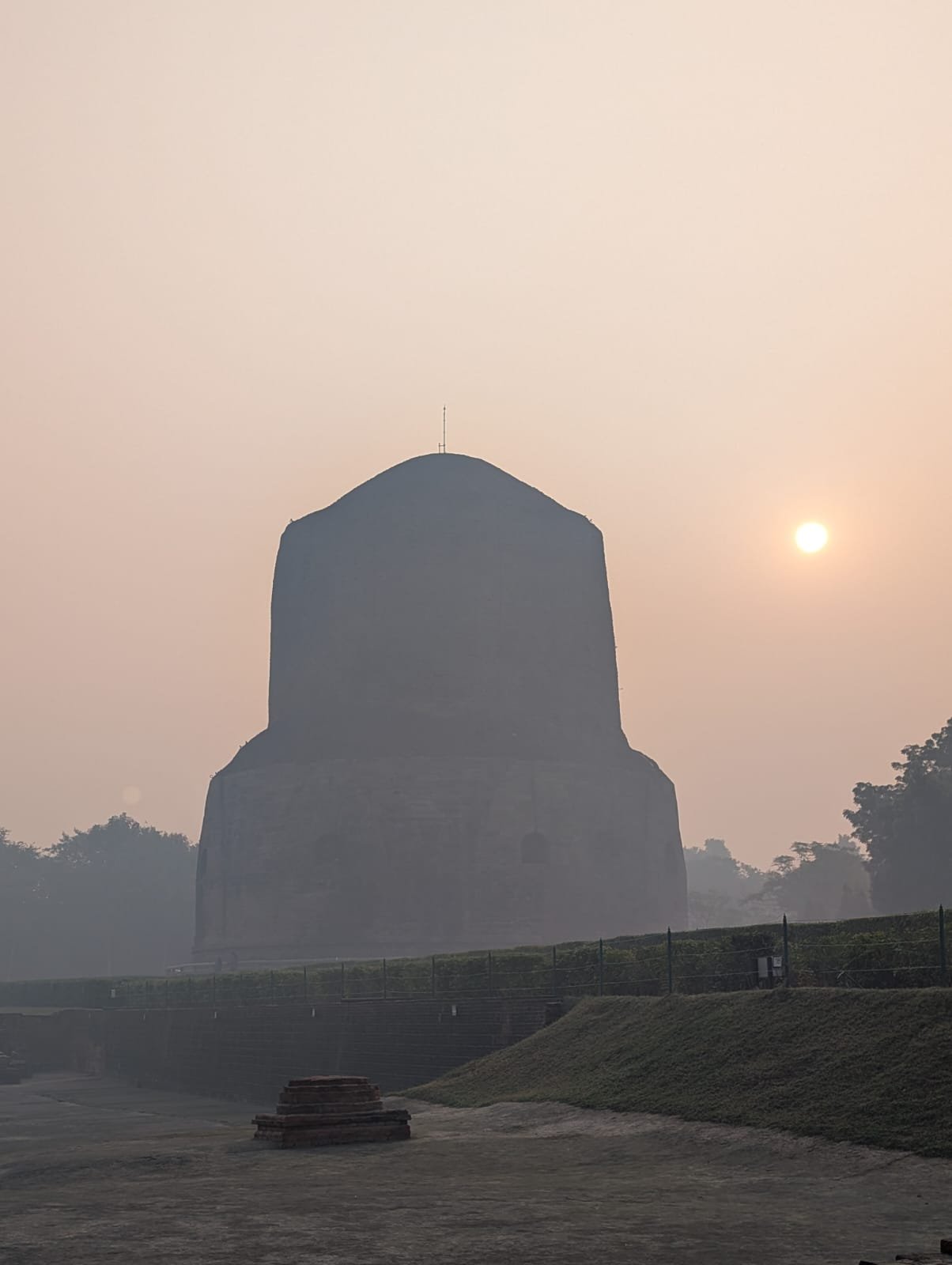Buddhist Art at Sarnath
Writing and Photos (taken in Dec 2024) by Ju-Lyn
Sarnath, near Varanasi, India, today is a bustling location visited by pilgrims from all over the world, as well as many local tourists and students. Here is a photo journal especially for Buddhist Artists.

The Deer Park
For Buddhists, at the heart of a visit to Sarnath, is the Deer Park, where a magnificent ancient stupa stands.
Dhamek Stupa
The Dhamek Stupa supposedly marks the site where the Buddha first taught. It is where, over 2,500 years ago, the historical Buddha first taught the Dhamma to five students. He had walked to the Deer Park in Sarnath (Migadaye or Isipatane) from his place of enlightenment (at Bodhgaya), searching for his previous ascetic companions. When he found the five of them, he explained the Four Noble Truths, upon which, one of the disciples, Ven Koṇḍañña attained enlightenment on the spot, as the others also decided to follow the Buddha’s teachings. These events are recorded in Dhammacakkappavattana Sutta (Setting the Wheel of Dhamma in Motion) (SN 56:11).
Thusly, Deer Park is where the Triple Gems first came into fruition: for it was there that the Buddha first taught, and where the Dhamma first manifested in form, and where the Sangha (practicing disciples of the Buddha) came to be. Besides the monastics, not long after this momentous occasion, at Deer Park, the Buddha would also meet with the first lay disciples who took refuge in the Triple Gems.
Dharmarajika Stupa
Nearby is another site of a large stupa, Dharmarajika Stupa that likely marks where a portion of the Buddha’s cremated remains was buried; unfortunately, this stupa had been taken down for its building materials, by a local ruler of the area. Only the foundations remain.
Mulagandha Kuty Vihara
Near these are the archaeological remains of Mulagandha Kuty Vihara (monastery) where the Buddha had stayed for his first rainy season, situated near the remains of an Asokha Pillar. The rest of the deer park complex is populated by remains of other viharas.
Sarnath Archaeological Museum
Another “must visit” at Sarnath is the Sarnath Archaeological Museum where the artefacts unearthed from the Deer Park are kept. For a long time, until recently in Nov 2024, cameras were forbidden in the museum. These photos were taken in Dec 2024. There are two major wings of the museum, with the left side featuring Buddhist art and the right side, featuring Hindu art, which was good to visit for a sense of contrast in aesthetics. The Hindu galleries, for example, feature a sense of movement and vibrancy, whereas the Buddhist ones emphasise stillness and a sense of quiet peace.
Lion Capital of Ashoka at Sarnath
For a small museum, the exhibitions hold at least two important artworks significant to the whole of the Buddhist world. One is the Lion Capital of Ashoka at Sarnath (BCE 250), which is the capital that adorned the top of the cylindrical column bearing the edicts of the famous king. It features four majestic naturalistically portrayed lions, facing four directions, with their backs to each other. India’s national emblem was adapted from this.
Buddha Preaching his First Sermon
The highlight, no doubt, is the image of the Buddha Preaching his First Sermon (5th century CE), also well-known as the “Sarnath Buddha” image, deemed by many as the most beautiful image in the world. It features the Buddha seated in the full-lotus position with his hands in the mudra of "turning the wheel of Dhamma". A guide explained that the mudra is derived from depicting the hands undoing a knot in a piece of cloth. The bottom panel features a wheel flanked by the five ascetics. There is, additionally, a woman and her child on the left side, commonly thought of as being the donor of the image and her child. At the back of the Buddha is a circle surrounded by a “wreath” of flowers at the top of which two devas are featured, one on each side. One possible interpretation is that this is an abstract depiction of the devas showering flowers, with the circle acting like a halo or glow emitting from the Buddha's presence. This work is worth spending a significant amount of time to study indeed.
This other Buddha image from the same period suggests of how the nose of the Sarnath Buddha might have looked originally.
Temples in Sarnath
Like the other major Buddhist pilgrimage sites, Sarnath has many temples from the major Buddhist cultures from all over the world, like Tibet, Japan, Thailand, Burmese, Sri Lankan, and many more.
Bamiyan Buddha Replica
Of special interest to artists may be the Thailand temple which features a large Buddha image that is meant to be a replica of the Buddhas of Bamiyan in Afghanistan that were destroyed by the Taliban in 2001.
Sri Lankan Mulagandha Kuty Vihara
While many of these temples feature intricate murals on their walls, of note is the Sri Lankan Mulagandha Kuty Vihara which features elaborate mural fresco paintings by renowned Japanese artist Kosetsu Nosu (1885- 1973) and his assistant, depicting the life events of Sakyamuni Buddha. It is a remarkable testament to the internationalisation of Buddhism, which began, more than 2,500 years ago, in Sarnath.







